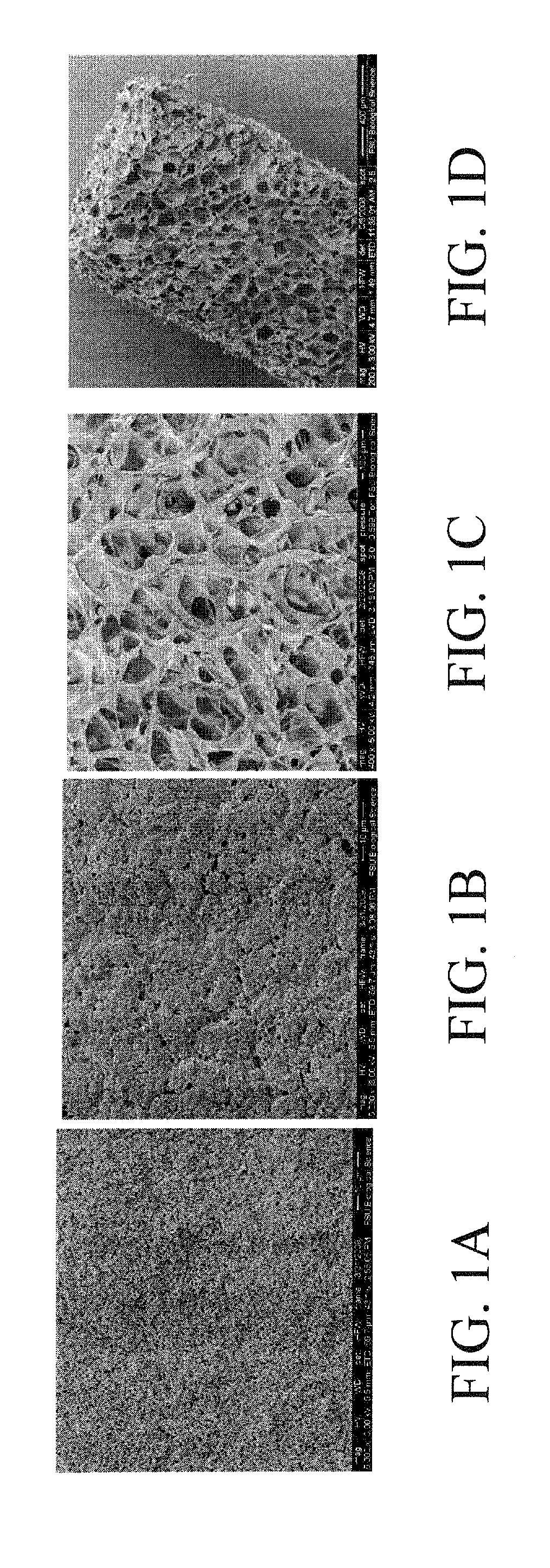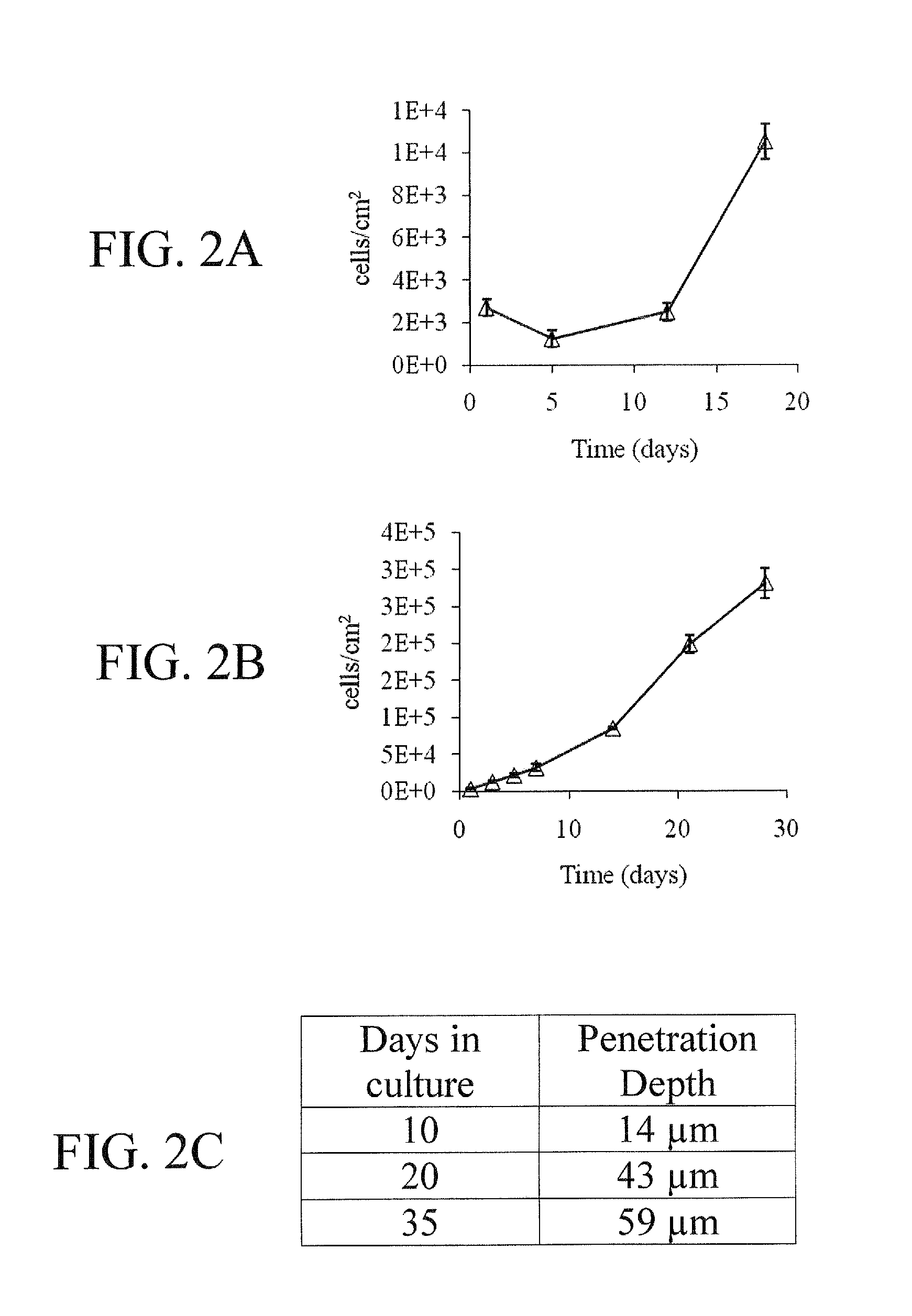Dual-chamber perfusion bioreactor for orthopedic tissue interfaces and methods of use
a bioreactor and orthopedic tissue technology, applied in tissue culture, tissue after-treatment, prosthesis, etc., can solve the problem of not being able to control the communication between different regions of the construct, and achieve the effect of modulating the interaction and communication
- Summary
- Abstract
- Description
- Claims
- Application Information
AI Technical Summary
Benefits of technology
Problems solved by technology
Method used
Image
Examples
example 1
[0048]With reference to FIGS. 1-8, hMSC exhibit rapid proliferation in preincubated HCG due to cell migration into the matrices, indicating excellent biomimetic properties HCG's inherent osteoinductive properties without chemical induction is confirmed by hMSC's alkaline phosphatase (ALP) activity and osteogenic gene expression quantified by qPCR. Sustained substrate mediated transfection by incorporating chtiosan-BMP-2 nanoparticles at 28 days of culture is confirmed by q-PCR, demonstrating the potential for achieving sustained gene delivery in HCG matrices. hMSCs maintained their osteogenic differentiation ability after extensive perfusion growth in the HCG scaffolds, indicating the potential of bioreactor for streamlined construct fabrication.
Materials and Methods for Examples 2-4
[0049]Materials. Medium molecular weight chitosan and gelatin from bovine skin were purchased from Sigma Chemical Co. (St. Louis, Mo., USA). Hydroxyapatite (HA) powder with an average particle diameter o...
example 2-3d
Porous HCG Scaffold Fabrication
[0060]The 3D HCG scaffolds were prepared by lyophilization, following an established procedure reported in our early studies (Zhao et al., 2002, 2006). An inverse correlation between pore size and freezing temperature was found to be in agreement with previous reports, indicating that the pore structure of the HCG scaffolds can be readily adjusted by regulating the freezing temperature (O'Brien et al., 2005; Zhao et al., 2002). The surface texture of the scaffolds under all freezing conditions appeared rough, with pore sizes serving as suitable templates for cell adhesion, migration and growth, varying from 99±24 μm for HCG80 scaffolds to 158±23 μm in the HCG20 scaffold (FIG. 10).
[0061]Table 2 lists the pore size of each fabricated scaffold, detailing the effect of freezing temperature on final construct pore size.
TABLE 2Freezing TemperaturePore Size−80° C. (HCG80) 99 ± 24 μm−50° C. (HCG50)128 ± 38 μm−20° C. (HCG20)158 ± 23 μm
example 3
Cell Seeding and Preconditioning
[0062]Seeding efficiency had an inverse relationship to both flow rate and pore size, as shown in FIGS. 11A and 11B. However, preconditioning of the HCG scaffolds in serum containing media had no effect on cell-seeding efficiency at 1.0 ml / min (FIG. 11C). DAPI images obtained from depth filtration 6 h after seeding at 1.0 ml / min show good cell penetration and distribution throughout the 1 mm thickness of the scaffolds (FIGS. 11D and 11E). SEM images of preconditioned samples (FIGS. 12A-12C) displayed a more fibrous surface texture after 7 days of complete medium preconditioning, giving it a less rough appearance as compared to samples stored in PBS (FIGS. 12D-12F) over the same time period. Preconditioning also induced the appearance of nanopores on the surface of the scaffold (FIG. 12C) when imaged at ×30,000. Preconditioning did not appear to effect the overall pore structure of the HCG scaffold (FIGS. 12A and 12D).
[0063]To examine the impact of per...
PUM
| Property | Measurement | Unit |
|---|---|---|
| Diameter | aaaaa | aaaaa |
| Diameter | aaaaa | aaaaa |
| Length | aaaaa | aaaaa |
Abstract
Description
Claims
Application Information
 Login to View More
Login to View More - R&D
- Intellectual Property
- Life Sciences
- Materials
- Tech Scout
- Unparalleled Data Quality
- Higher Quality Content
- 60% Fewer Hallucinations
Browse by: Latest US Patents, China's latest patents, Technical Efficacy Thesaurus, Application Domain, Technology Topic, Popular Technical Reports.
© 2025 PatSnap. All rights reserved.Legal|Privacy policy|Modern Slavery Act Transparency Statement|Sitemap|About US| Contact US: help@patsnap.com



